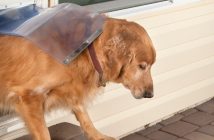There are a number of good reasons to let your dog run free outdoors, including the good health of your furry friend and to help prevent them from running amok inside your home; but making a garden dog-friendly can be tougher than you might expect. Gardening is a very popular pastime, and dogs can have a habit of ruining fledgling plants. Additionally, they’re curious creatures who will endeavor to find a way out of even the most secure garden.
Plants
It’s hard to predict which plants a dog will be tempted to rip up and when, but there are certain measures you can take to protect your plants. Some people erect small fences around vulnerable plants to protect them from dogs, and although most dogs are capable of jumping a 1ft fence they are much less likely to. There are other preventative measures you can take including buying larger plants for the garden, as small ones are much more susceptible to attack.
Paths
Although dogs are quite happy running around in open spaces, like humans they are very suggestible and will tend to use paths if they are present. Solid paving stones are better than gravel, as the latter can seem like the perfect material to go digging in. If creating a path doesn’t succeed in discouraging your dog from trampling your flower beds, then you might consider planting flowers more tightly together, as this may discourage the dog if they can’t see any easy way through.
Shade
Especially if the dog is supposed to be in the garden for long periods of time, you should make some shade available. In hot weather dogs will look for a cool place to relax, so provide shaded areas where they can lay and cool down.
Poisonous plants, pesticides and herbicides
Young dogs are especially prone to eating plants, so find out if any of your plants could be poisonous to your dog. Common plants such as daffodils, foxgloves and rhubarb can all be poisonous to dogs, so it’s well worth finding out. Herbicides and pesticides might not be poisonous, but they can make a dog sick so you should try to restrict their use. Consider using more holistic approaches to reduce pests and weeds. If you need to use chemicals on part of your garden then try to keep your dog away from the area for a few days at least.
Grass
Decking, patios and gravel might be popular, but dogs love to run, and they do it best on grass. Provide some open space for your dog to run in. This way they will be less likely to start digging or barking. If you don’t provide some grass for a dog to run around, then expect them to run through your flower beds.
Fencing
When it comes to fencing it all depends on your dog. Smaller dogs might be able to be contained by relatively small garden fences, but remember that fencing also provides safety and security for your home. If you have a larger dog who either reacts badly to passing people, animals or traffic, or you feel that your home is vulnerable to thieves then you might consider a high privacy wall. This will prevent the dog from being too interested in what’s going on outside and prevent onlookers to see in.
Remember that dogs will try to squeeze through any sort of gaps in fences, as well as trying to jump over the top. They will also attempt to use other garden items such as wheelie bins or garden furniture to help them climb the wall or fence. If that’s not enough, many dogs will also try to dig underneath garden fencing. You can stop this from happening by digging a few feet and sinking fence panels into the ground.
But don’t let me put you off!
Creating a dog-friendly garden can be relatively easy if you use your common sense. Look at your garden from the dog’s perspective if you can’t work out their behavior. And good luck.
This article was contributed by Bill Weston, a dog-lover and avid gardener. He has a number of mixed-breed dogs and successfully manages to let them run free in his garden.
Image used under a creative commons license courtesy of Todd Dwyer on Flickr




12 Comments
Good guardian of the garden!
This post offers so many dog-friends tips, which I need because of my dog! She constantly digs at my tomato plants! I think it’s important to leave that extra space like you recommended for dogs to have their own running/ mischief area in the backyard.
I have two dogs and they live half inside, half outside they love to be on the dirt !! Great article I look forward to see more posts! Thank you <Mobile Dog Grooming Miami
Truly, I agree with you. Dogs need to sometimes run freely to gain more stamina.
Thank you for these tips! Like every pet owner with a backyard garden. I have a problem with my dogs lurking around my backyard and digging with my plants.I love my dogs and I also love to keep my plants in our backyard. So base on my experience fencing is the best method that l used to separate the two colliding world.. 🙂
Very informative article. I might also add that dogs sometimes like to eat grass for stomach aches, so havng some in your backyard is a good idea. Checking to see if the plants are poisonours is mandatory, as is securing the yard with a proper fence. My dog has learned to leave the plants alone. One reason maybe that I have alot of my plants in planters so my dog cannot dig around them. He has initially chewed, but after a couple discipline commands he did stop. Living in Arizona shade and water are survival for the comfort and health of one’s dog. I enjoyed the article very much.
This is definitely a very informative article that a pet owner should read. Dog can be a good guardian of your garden. So I love to add that putting a fountain in the backyard will help the dog quench their thirst. In addition, fountains are lovely garden decoration. 🙂
Its always good to take our pets to the garden. But while taking them out, great care should be taken and the points you have shared are some of the major factors for which care should be taken. And among all pets dogs are the most toughest to handle outside.
My pet really enjoys to stay in the garden. Most especially when my dad is out there checking on the plants. He gets muddy all over his paws and loves to run in the garden. The good things is that we already removed any plants that may cause harm to him and constantly check on insects and such.
I think it is nice to take your pets out once in a while. However, they also have some tendency of ruining your garden. You have to make sure that you to teach them the boundaries as well as to teach them what not and what are the things that they can touch in the garden.
Well, if you do plan on planting something in your garden then make sure that you secure it from your dogs. Or you can also train your dogs not to touch the plants in your garden.
Pingback: Lovable Dogs Top 6 Tips For A Dog Friendly Garden - Lovable Dogs